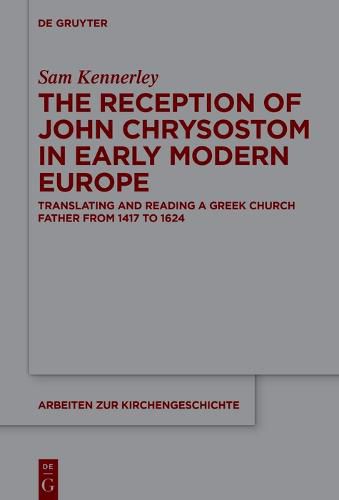Readings Newsletter
Become a Readings Member to make your shopping experience even easier.
Sign in or sign up for free!
You’re not far away from qualifying for FREE standard shipping within Australia
You’ve qualified for FREE standard shipping within Australia
The cart is loading…






This title is printed to order. This book may have been self-published. If so, we cannot guarantee the quality of the content. In the main most books will have gone through the editing process however some may not. We therefore suggest that you be aware of this before ordering this book. If in doubt check either the author or publisher’s details as we are unable to accept any returns unless they are faulty. Please contact us if you have any questions.
It is now widely accepted that Latin scholars in early modern Europe were crucial to the transmission and interpretation of Greek patristic texts. What is less remarked upon is that these Latin figures were contemporaries of a living Greek tradition of reading the Church Fathers, a tradition nurtured by Greek scribes and scholars, and the manuscripts and printed books that they preserved, created, and interpreted.
The interaction between Greek and Latin patristic scholarship in the early modern period forms the core of John Chrysostom from Antioch to Eton. Exploring the years between the first neo-Latin translation of Chrysostom in 1417, and the completion of Sir Henry Savile’s monumental Greek edition in 1613, this book guides the reader through the reception of Chrysostom in the Italian Renaissance, Erasmus’s Basel, the opera omnia of the Reformation and Counter-Reformation, and the Greek world in the century and a half after the fall of Constantinople.
By drawing on a range of evidence from translations to conciliar acts, this study concludes that not only was John Chrysostom ‘latinised’ in early modern Europe, but that the image of Chrysostom developed in the Renaissance and Reformation continues to inform scholarship today.
$9.00 standard shipping within Australia
FREE standard shipping within Australia for orders over $100.00
Express & International shipping calculated at checkout
This title is printed to order. This book may have been self-published. If so, we cannot guarantee the quality of the content. In the main most books will have gone through the editing process however some may not. We therefore suggest that you be aware of this before ordering this book. If in doubt check either the author or publisher’s details as we are unable to accept any returns unless they are faulty. Please contact us if you have any questions.
It is now widely accepted that Latin scholars in early modern Europe were crucial to the transmission and interpretation of Greek patristic texts. What is less remarked upon is that these Latin figures were contemporaries of a living Greek tradition of reading the Church Fathers, a tradition nurtured by Greek scribes and scholars, and the manuscripts and printed books that they preserved, created, and interpreted.
The interaction between Greek and Latin patristic scholarship in the early modern period forms the core of John Chrysostom from Antioch to Eton. Exploring the years between the first neo-Latin translation of Chrysostom in 1417, and the completion of Sir Henry Savile’s monumental Greek edition in 1613, this book guides the reader through the reception of Chrysostom in the Italian Renaissance, Erasmus’s Basel, the opera omnia of the Reformation and Counter-Reformation, and the Greek world in the century and a half after the fall of Constantinople.
By drawing on a range of evidence from translations to conciliar acts, this study concludes that not only was John Chrysostom ‘latinised’ in early modern Europe, but that the image of Chrysostom developed in the Renaissance and Reformation continues to inform scholarship today.